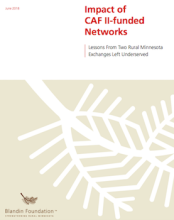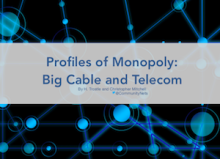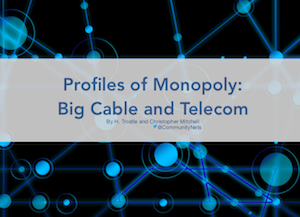
Fast, affordable Internet access for all.

On September 26th, Republican FCC Commissioners adopted an Order that usurps local control and, in keeping with this administration’s prior policy decisions, strengthens the power of the largest companies, obtaining nothing in return.
Bad Reasoning
At issue are local governments’ ability to determine the amount of fees to charge mobile carriers that want to place 5G equipment in rights-of-way. In addition to establishing fees, the Order sets strict timelines in which cities and towns must respond to carrier applications. The FCC decision eliminates local communities’ ability to negotiate in order to protect their own rights-of-way and the poles, traffic lights, and other potential structures in them.
To back up their decision to adopt the new policy, the Republican controlled FCC relied on the incorrect claims that application and attachment fees in larger communities are so excessive that they create a burden which prevents carriers from investing in rural communities. Former FCC Chief of Staff and one of the architects of the 2010 National Broadband Plan Blair Levin echoed the thoughts of policy analysts and thought leaders in telecommunications:
"[E]ven if one accepts the FCC claim about the $2.5 billion—which is highly questionable—that amount is about one percent of what the FCC and industry claim is the necessary new investment needed for next-generation network deployments and, therefore, is not likely to have a significant impact," he wrote.
The FCC does not require mobile carriers to commit to expanded coverage in smaller communities within the Order. Next Century Cities describes the situation in a press release:
These low fees would create a de facto public subsidization of industry investment. … The FCC is just giving private wireless companies all of the benefits of a utility without any traditional public interest obligations.
FCC Commissioner Jessica Rosenworcel, who has continued to oppose the Order, described the giveaway:
According to the Federal Communications Commission (FCC), at least 35 percent of tribal residents do not have access to fixed broadband. In comparison, only 7.7 percent of all U.S. residents lack access to fixed broadband, defined as minimum speeds of 25 Megabits per second (Mbps) download and 3 Mbps upload.
However, a recent report from the Government Accountability Office (GAO) concludes that this disparity is probably even starker.
The report, prepared at the request of the U.S. Senate Committee on Indian Affairs, finds that the FCC’s broadband data is inadequate and inaccurate. As a result, the data overstate sbroadband availability nationwide, particularly in tribal areas. Additionally, the report notes that the FCC fails to engage tribes in the data collection process.
Bad data isn’t just a bureaucratic recordkeeping problem. Tribal communities can miss out on federal funding to improve connectivity in unserved and underserved areas if the FCC data shows that they already have access to broadband.
Reporting Methodology Overstates Access
For the most part, the FCC gets its information on fixed broadband availability through Form 477. Internet service providers (ISPs) submit the form twice a year, listing the census blocks they serve and the highest speeds they advertise.
This data collection methodology inherently exaggerates Internet access. Since ISPs report coverage by census block, an entire block is considered served even if the provider offers, or could offer, access to only one home.
 Many tribal lands are located in rural areas, the report notes, where large census blocks result in vast overstatements of broadband availability. Census blocks can also contain both tribal and non-tribal lands, further obscuring the extent to which tribal communities lack connectivity.
Many tribal lands are located in rural areas, the report notes, where large census blocks result in vast overstatements of broadband availability. Census blocks can also contain both tribal and non-tribal lands, further obscuring the extent to which tribal communities lack connectivity.

A year ago, we last had Jonathan Chambers of Conexon on the podcast to discuss the pros and cons of the Connect America Fund. Since then, the FCC has held an auction to expand connectivity in rural areas as part of the Connect America Fund Phase II (Auction 903) and recently released news of the winning bidders. In episode 321 of the podcast, he’s back for another conversation on the process and the results.
In addition to a brief history on the Connect America Fund, Jonathan and Christopher spend some time discussing the arguments for and against federal funding dedicated to rural deployment. Do ISPs really want to serve residents and businesses in rural areas? Based on the results of the auction, the answer is yes.
As Jonathan notes, this year’s bidding process has been more transparent in years past, but in order for the program to be a true success, there also needs to be accountability. Christopher and Jonathan also discuss the results from this auction and the strong showing that rural electric cooperatives made in the auction. They talk about some of the technological challenges that may arise for some of the bidding firms that promised results that may be beyond their capabilities. Christopher and Jonathan also discuss some of the areas of the country where firms receiving Connect America Funds will deploy.
You can view lists of bid winners and the news release about the auction at the FCC website. There are also maps available at the FCC, to offer visual representations of areas to receive infrastructure, along with eligible areas, and related documents.
This show is 51 minutes long and can be played on this page or via Apple Podcasts or the tool of your choice using this feed.
Transcript below.
We want your feedback and suggestions for the show-please e-mail us or leave a comment below.
Listen to other episodes here or view all episodes in our index. See other podcasts from the Institute for Local Self-Reliance here.
Thanks to Arne Huseby for the music. The song is Warm Duck Shuffle and is licensed under a Creative Commons Attribution (3.0) license.
Shortly after Republican FCC Commissioners repealed federal network neutrality protections late in 2017, state lawmakers began introducing legislation to protect their constituents. California’s AB 1999, introduced as one possible antidote to the FCC failure in judgment, passed the General Assembly on August 29th and is on its way to Governor Jerry Brown.
Read the final version of the bill and the Legislative Counsel Digest here.
Let the People Serve the People
As local communities have investigated ways to protect themselves from throttling, paid prioritization, and other activities no longer banned, they’ve looked at investing in publicly owned infrastructure. Rural communities where national Internet service providers are less motivated to deploy have always struggled to attract investment from the same large companies known to violate network neutrality tenets. Assembly Member Ed Chau’s AB 1999 addresses rural communities’ need for better connectivity, solutions that can preserve network neutrality, and challenges in funding broadband infrastructure.
California’s community service districts (CSDs) are independent local governments created by folks in unincorporated areas. CDSs provide services that would otherwise be provided by a municipality. Residents usually join together to form a CSD and do so to establish services such as water and wastewater management, garbage collection, fire protection, or similar services. A CSD also has the ability to create an enhanced infrastructure financing district (EIFD) in order to finance the development of a broadband network.
The EIFD statute granting the authority allows communities, including CSDs, to join together regional projects for a range of financing purposes. Tax Increment Financing (TIF) and various bonding mechanisms are a few examples.

The Connect America Fund provides annual federal funding to some of the largest telecommunications providers, but it can be hard for local officials to know where these dollars go.
This report digs deep into the federal subsidies for Internet service in Minnesota. Researcher Bill Coleman of Community Technology Advisors led a Blandin Foundation project that explored how federal Connect America Fund dollars have been used in two Minnesota telephone exchanges. In the end, researchers found that these networks would likely not meet Minnesota’s state connectivity goals.
While digging through a paper trail of right-of-way agreements and local permits, researchers also went out into the field to find the actual infrastructure in the communities. They identified DSLAMs where fiber-optic lines connect to the copper DSL lines that run to people’s homes.
Using the locations of the DSLAMs, researchers mapped where people can likely receive federal government defined broadband of 25 Mbps download and 3 Mbps upload. The maps also show where people can likely get 10 Mbps download and 1 Mbps upload which is the standard for the Connect America Fund subsidy.
The 27-page report goes into detail on the connectivity available in the two telephone exchanges. The researchers conclude by explaining:
“In sum, CAF II investments in Minnesota are being spent to build networks that don’t meet today’s federal definition of broadband and won’t meet state goals for the future. Moreover, lack of transparency in proposed CAF II network plans and timelines is making it difficult for impacted communities to plan accordingly to ensure their broadband needs are being adequately met.“ (Page 22)
Download Impact of CAF II-funded Networks: Lessons From Two Rural Minnesota Exchanges Left Underserved from the Blandin Foundation.

For years, national cable and telecom companies have complained that they work in a tough industry because “there’s too much broadband competition.” Such a subjective statement has created confusion among subscribers, policy makers, and elected officials. Many people, especially those in rural areas, have little or no choice. We wanted to dive deeper into the realities of their claim, so we decided to look at the data and map out what the large carriers offer and where they offer it. In order to share our findings with policy makers, local elected officials, and the general public, we’ve created a report that includes series of maps to illustrate our findings and our analysis, Profiles of Monopoly: Big Cable and Telecom.
Choice, Data, the FCC
In this analysis, we examined Form 477 Data from ISPs and submitted to the FCC. While the data paints a grim picture of where competition truly exists, those who read the report should remember that Form 477 Data breaks down information into census blocks. As a result, the Form 477 overstates broadband service availability and the size of coverage areas. With this in mind, we believe the reality on the ground is even worse than what FCC data shows.
In the report, we shared our thoughts on the data from the FCC:
We have deep hesitations about using this data because of its many inaccuracies, but there is no other feasible option. In any event, this provides a conservative baseline for the problems in the market - though we believe the true level of competition is worse than this analysis shows, neither is tolerable in a country that claims to support a market-driven solution for supplying broadband Internet access.
Important Findings

If you haven’t already taken a look at our most recent report, now is your chance to get some insight before you download it and dive in. Profiles of Monopoly: Big Cable and Telecom, written by our Hannah Trostle, recently left ILSR to attend grad school, and Christopher Mitchell, transforms FCC Form 477 data into a series of maps that reveal a sad state of competition in the U.S. broadband market. For episode 317 of the podcast, Hannah and Christopher discuss the report and the main findings.
Hannah and Christopher provide more insight into the main findings of the report, which analyzes where competition exists and where large national providers fail to invest. The result ultimately creates densely populated areas with more competition for broadband (as defined by the FCC) than rural areas. Due to their de facto monopolies, the top national providers capture huge segments of the population.
Hannah and Christopher also talk about the quality of the Form 477 data and the need for better benchmarks, we learn about why Hannah and Christopher felt that it was time to take the data and turn it into a visual story. You’ll learn more about their methodology in developing the maps and their analysis. Hannah, who created the maps that make the foundation of the report, shares some of the surprises she discovered. The two talk about the Connect America Fund and the policies behind the program and how the results have aggravated lack of broadband in rural America and how cooperatives are picking up the slack where big corporate ISPs are failing rural America.
 If you want to learn more about how cooperatives are running circles around the big ISPs in rural areas, download our 2017 report, Cooperatives Fiberize Rural America: A Trusted Model for the Internet Era.
If you want to learn more about how cooperatives are running circles around the big ISPs in rural areas, download our 2017 report, Cooperatives Fiberize Rural America: A Trusted Model for the Internet Era.
This show is 37 minutes long and can be played on this page or via Apple Podcasts or the tool of your choice using this feed.
Transcript below.
We want your feedback and suggestions for the show-please e-mail us or leave a comment below.
Listen to other episodes here or view all episodes in our index. See other podcasts from the Institute for Local Self-Reliance here.
Thanks to Arne Huseby for the music. The song is Warm Duck Shuffle and is licensed under a Creative Commons Attribution (3.0) license.
If you couldn’t make it to Pittsburgh for “Making Connections” with Next Century Cities in July, you can still almost be there. The Internet Society has now archived the video footage of the event — speeches and panels — and made them available online.
Among the videos, we recommend Blair Levin’s keynote and the panel moderated by our Christopher Mitchell. In Blair’s speech he speaks about the importance of local authority as communities across the U.S. try to find the best way to deploy high-quality Internet access. Blair’s speech focuses on how smart cities and smart policy depend on learning and how the FCC’s Broadband Deployment Advisory Council (BDAC) is earning a failing grade. Through its imbalance in membership, misconceptions about the power of the telecommunications industry, and inability to negotiate properly it's placing too much power in the hands of already powerful ISPs.
The results won’t bring broadband to those who need it, won't facilitate smart city technologies, and seems designed only to confirm what they want to believe, which is that local communities should not have control over their own connectivity solutions.
You can check out all the videos from the event here.
Read the text of the speech or watch video of Blair’s speech and the panel that follows:
For years, national cable and telecom companies have complained that they work in a tough industry because “there’s too much broadband competition.” Such a subjective statement has created confusion among subscribers, policy makers, and elected officials. Many people, especially those in rural areas, have little or no choice. We wanted to dive deeper into the realities of their claim, so we decided to look at the data and map out what the large carriers offer and where they offer it. In order to share our findings with policy makers, local elected officials, and the general public, we’ve created a report that includes series of maps to illustrate our findings and our analysis, Profiles of Monopoly: Big Cable and Telecom.
Choice: The Ultimate Prize
Whether it’s a brand of breakfast cereal, a model of car, or an Internet Service Provider (ISP), those who purchase a good or service know that when they have more options, the options they have are better. The FCC defines "broadband" as connectivity that provides speeds of at least 25 Megabits per second (Mbps) download and 3 Mbps upload; our report fouces on service where ISPs claim to offer this minimum threshold.
When it comes to ISPs, subscribers often have a faux choice between unequal services, such as one telephone company offering slow DSL and one cable company that offers faster cable Internet access. People in rural America often have even slimmer options because cable ISPs don’t provide broadband in less populated rural areas. In other words, the market has spoken and the market is broken.
In his recent article written for NBC News, journalist Phil McCausland examines the impacts broadband access can have on rural communities and the challenges that persist in bringing coverage to these isolated areas. Reliable high-speed internet access can spark economic development in some of the United State’s most cash-strapped areas, but a lack of dependable data makes acquiring funding difficult.
McCausland explores how high-speed Internet access is becoming increasingly essential for communities’ economic growth. He spoke with Roberto Gallardo, the assistant director of the Purdue Center for Regional Development, who explained how having broadband access today “is analogous to the installation of a railroad 100 years ago or a highway 50 years ago.”
Bringing Broadband to Rural Areas
McCausland investigates the specific case of Lake County, Minnesota, an area home to 10,000 people that spans 3,000 square miles in the far northeast part of the state. Our 2014 report, All Hands on Deck: Minnesota Local Government Models for Fiber Internet Access, describes how the Minnesota legislature set a goal in 2010 to achieve universal access to high speed broadband throughout the state by 2015, including in Lake County. Many of Minnesota’s local governments stepped up to try to accomplish the goal. Local leaders in Lake County decided that they needed high-speed internet in order to take part in the growing digital economy. McCausland found that after nearly eight years of planning and an investment of over $80 million dollars, the area is seeing the economic benefits of high-speed Internet access. Coverage has boosted tourism and allowed for lifestyles that involve working remotely, as well as becoming essential to the growth of local businesses.